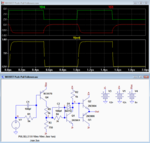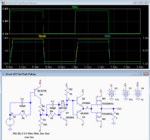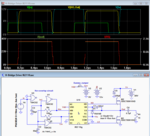edobp
Newbie level 4
hello all.
im planning to convert 1mhz pwm from a microcontroller (5v and gnd) to a positive and negative (+20v and -20v) pwm (1mhz). I already did this by using a bjt transistor (bd139 and bd140), please see the pict below.

the circuit above works to convert the (+5v/gnd) pwm to (+20v/-20v) pwm with 100 kHz frequency. but when i raised the frequency to 1mhz the output was gone missing (drop to 0v). could anyone help me to get the solution of my problem? sorry if my explanation is pretty confusing, but it understanable, thank you.
im planning to convert 1mhz pwm from a microcontroller (5v and gnd) to a positive and negative (+20v and -20v) pwm (1mhz). I already did this by using a bjt transistor (bd139 and bd140), please see the pict below.

the circuit above works to convert the (+5v/gnd) pwm to (+20v/-20v) pwm with 100 kHz frequency. but when i raised the frequency to 1mhz the output was gone missing (drop to 0v). could anyone help me to get the solution of my problem? sorry if my explanation is pretty confusing, but it understanable, thank you.


